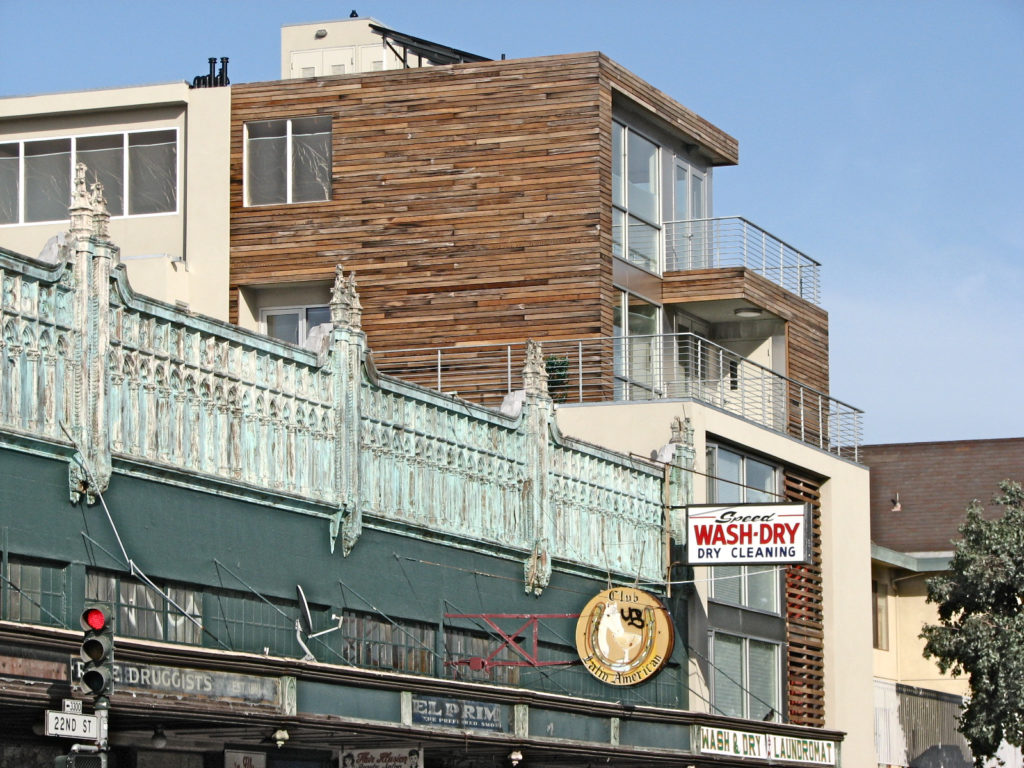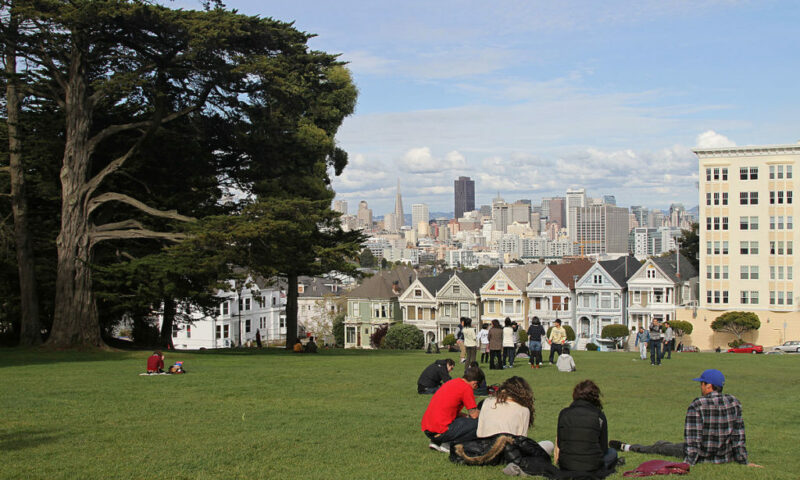Priced Out
Priced Out: Middle Class 2.0
Co-published by Fast Company
Is our budding tech utopia setting the stage for a working-people’s dystopia? Welcome to California’s cost-of-living crisis.

Are longtime San Francisco residents just collateral damage of the tech boom, or is their dispersal a necessary feature
of a new economy?
The Internet has become society’s collective brain; an awe-inspiring collection of texts, photos, videos, drawings, research data, communications tools and how-to guides. The ultimate impression for DIY technophiles is that we can learn to do just about anything we want. “You have,” as tech thinker Byron Reese explained in a recent interview, “the powers of gods now.”
That may be true, but gods likely live better and with a lot less anxiety than the majority of Californians these days. Yes, the tech titans—people like Elon Musk, Jeff Bezos and their acolytes—seem to be doing fine in palatial homes from the hills of San Francisco and flatlands of Silicon Valley to the waterfronts of Malibu and Venice’s Silicon Beach. And many of the industry’s well-compensated employees—like the typical Facebook employee who last year earned $240,000—can still squeak by in white-hot real estate markets near their work. But given the outsized space that blossoming tech-and-innovation companies are filling, especially in formerly middle-income neighborhoods of California’s cities, it is reasonable to ask: How much room will they leave for the rest of us?
A Darwinian moment is eliminating a once-fundamental position in a growing number of restaurants: The waiter.
The rules of American capitalism, after all, are anchored to “creative destruction”; old models break down as more successful ones emerge. The pace of change in the San Francisco model is key to why so many working people are bailing on a thriving, charismatic town, or are considering doing so. It raises a question: Are they just collateral damage of the economic boom, or are the forces pushing them out a necessary feature of a new economy that needs to free up space in a tight housing market? Basically, if you can’t build enough new housing for much-needed employees—managers, engineers, coders, designers, data scientists and the like—you need to liberate the housing of people who aren’t as important to your business model. This process is happening largely via the old capitalistic method of outbidding people.
Today this Darwinian moment is consuming an ever-increasing array of once-fundamental job positions in a growing number of restaurants in the city, including: The waiter. But could tomorrow lead traditional teachers, police officers, tax accountants, bus drivers and many others to be declared cost-ineffective and therefore obsolete?
For those thinking it makes more sense to rent than own, San Francisco’s tenants pay more for a run-of-the-mill apartment than New Yorkers.
San Francisco, a city of 870,000 people who are packed into the most densely populated major American city west of New Jersey, has long had tight limits on home construction. This has meant that the hundreds of thousands of new jobs that the tech-and-innovations sector created in recent years haven’t come with suitable housing options for incoming employees. Throw in a flood of money—hundreds of billions of dollars from those companies—and the result is surging prices in a tech metropolis that continues to draw new arrivals who either have lots of cash or who hope to earn it there.
In much of urban California, historically middle-class professionals—firefighters, homebuilders, young lawyers and countless others lower down the economic food chain—can no longer afford to buy homes because they simply can’t compete in their local real estate markets.The California Association of Realtors calculated early this year that it took an annual income of more than $330,000 to afford the typical single-family home in San Francisco, as well as high six-figure salaries in many once-affordable parts of the East Bay. And for those thinking it makes more sense to rent, San Francisco’s tenants pay more for a run-of-the-mill apartment than New Yorkers. The result is a city where the median household income, which might sound generous to outsiders at nearly $97,000, affords only a low-income existence.
Peter Leyden: “Someone who is rooted in dying industries, in their fifties, is not going to retrain for the next era. It is cruel and sad . . . But it is kind of inevitable.”
Peter Leyden, a former editor at Wired magazine-turned-CEO of a San Francisco-based media startup, suggests that the phenomenon is due largely to an influx of brainpower and skilled labor that is so much more valuable than what was there before: “I’ve thought about the housing piece and how it is core to this middle-class squeeze,” says Leyden. “If you really pull back… This is a remake of the whole West Coast. You are watching a tech-driven innovation economy … that is being rebuilt in real-time.”
The Bay Area, he says, “is turning into a global city” on par with the peak historical moments for Paris, London, Hong Kong and New York. “A new middle class will emerge that is a California model, that doesn’t exist now,” Leyden says of the decade of change he envisions. “This is a good thing, but it is kind of being stuffed into an old thing.”
The cost of housing in San Francisco has risen so high, so quickly that the old supply-and-demand equations may be breaking down.
He acknowledges that certain people are not going to transition into the new economy. “There is without doubt a demographic segment of America and the West Coast that is not going to recover,” he says. “Someone who is rooted in dying industries, in their fifties, is not going to retrain for the next era. It is cruel and sad–and for the individual, it is horrifying. But it is kind of inevitable.”
“The old agreement was: If you work in the public sector; you will have pensions and consistent wages that you can use to afford ranch homes all over Southern California. That plan in the 21st century doesn’t work anymore. It is gone,” he adds. “Many of the extreme problems you’re seeing here, like homelessness and affordability, the gig economy and the lack of safety nets, are what happens when you go crashing helter-skelter into the future.”
“The old system is hanging on, and trying to prevent the next thing from being born,” he says, “but it is being born.”
When Real Estate Disrupts Work
The laws of supply and demand typically dictate that if enough important employees can’t afford market rents, their bosses will have to increase salaries so they can live close enough to hold their jobs. But the cost of housing in San Francisco has risen so high and so quickly that this equation may be breaking down.
Byron Reese: “The gig economy and the lack of safety nets are what happens when you go crashing helter-skelter into the future.”
Yes, some employees are simply seeking out market-rate housing that is ever-further from work in search of some semblance of affordability, and then they suffer through lengthening commutes in worsening traffic. But in that global capital of disruption, some seemingly indispensable jobs no longer seem absolutely necessary.
A growing number of high-end restaurants in San Francisco (and beyond) have made a transformative change. Some owners and managers, under financial pressure from sky-high commercial rents, concluded they cannot afford to pay their wait staff the $15 per hour minimum wage—a $4 per hour increase over the last four years. And even if they could, the wait staff still couldn’t rent out places within range of work. Management’s conclusion: Disrupt the restaurant experience and eliminate the wait staff. So, while they serve fine food, their customers pick up their own water, order wine at a counter and essentially engage in a pricey version of cafeteria dining.
The Half-Life of Jobs
Travel sites decimated travel agencies. Craigslist crushed newspaper classified advertising and the crucial revenue it produced. Online trading took stockbrokers down a few pegs. Online music sharing gutted the traditional music industry. The list seems endless.
“The half-life of a job is about 50 years. People learned to do new things then, and they will learn new things now.”
Often, such changes result in lower-paying, less stable jobs than the professions that were disrupted, and a larger share of profits tends to be channeled into fewer hands.
The concentration of wealth from other industries into tech and innovation specializations has, generally speaking, resulted in fewer people with outsized buying power; and then there are the rest of us who might enjoy the latest app or website—at least until the disruption they create affects our professions, or the housing markets we’re looking to afford housing in.
Byron Reese, who is the author of the recently published book The Fourth Age: Smart Robots, Conscious Computers and the Future of Humanity, sees this change in the context of epic transitions in human history. There have been key disruptive transformations, he explains, such as when animal power was replaced by steam engines, the advent of the assembly line and the electrification of the United States—all of which triggered a furious evolution of work and labor in remarkably short amounts of time.
“The half-life of a job is about 50 years,” Reese says. “People learned to do new things then, and they will learn new things now.”
Reese is undoubtedly correct in pointing out the almost magical components that tech has introduced into our lives. The industry has also generated unimaginable wealth for groundbreaking companies.
When he talks about us all having Star Trek-like medical tricorders that will tell us everything that is wrong with our bodies, and websites that offer us detailed, top-notch legal advice, or smart kitchen utensils that advise us about how to cook fine meals, it can start to sound like the latest utopian sales pitch in a state famous for promising, but not always delivering on, the establishment of a better world. “When you have technology like this, you get a flowering of humanity,” Reese says.
Seen from such a vantage point, says Reese, who has moved from Northern California to Austin, Texas with his family, “There is no way to wrap my head around this being bad for the Bay Area.”
It may not be bad for the Bay Area, just for many of its longtime residents–who can be forgiven for fearing that the burgeoning tech utopia could be the 21st century’s middle-class dystopia.
Read more of our “Priced Out” series here. Please join Capital & Main’s Facebook group on the cost of living in California to discuss problems and practical solutions. And follow Eric Pape on Twitter @ericpape, and let him know if you have a powerful story about the human impact of the price of life in the Golden State.
Copyright Capital & Main

-

 Latest NewsDecember 10, 2025
Latest NewsDecember 10, 2025Capital & Main, L.A. Times Win Sidney Award for Reporting on Child Farmworkers
-

 StrandedDecember 9, 2025
StrandedDecember 9, 2025Giving Up on the Dream: Asylum Seekers Try Other Options in Mexico
-

 Locked OutDecember 16, 2025
Locked OutDecember 16, 2025This Big L.A. Landlord Turned Away People Seeking Section 8 Housing
-

 Column - California UncoveredDecember 12, 2025
Column - California UncoveredDecember 12, 2025They Power the U.S. Economy, But Will Struggle to Afford Health Care
-

 The SlickDecember 19, 2025
The SlickDecember 19, 2025‘The Poor Are in a Very Bad State’: Climate Change Accelerates California’s Cost-of-Living Crisis
-

 Locked OutDecember 23, 2025
Locked OutDecember 23, 2025Section 8 Housing Assistance in Jeopardy From Proposed Cuts and Restrictions
-

 Column - State of InequalityDecember 11, 2025
Column - State of InequalityDecember 11, 2025A Little Place Called Home?
-

 Locked OutDecember 17, 2025
Locked OutDecember 17, 2025Credit History Remains an Obstacle for Section 8 Tenants, Despite Anti-Discrimination Law











